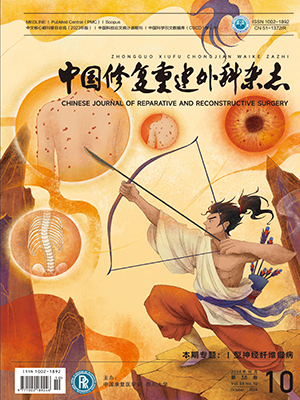Objective To investigate the preparation of decellularized Achilles tendons and the effect of co-culture of human fibroblasts on the scaffold so as to provide a scaffold for the tissue engineered ligament reconstruction. Methods Achilles tendons of both hind limbs were harvested from 10 male New Zealand white rabbits (5-month-old; weighing, 4-5 kg). The Achilles tendons were decellularized using trypsin, Triton X-100, and sodium dodecyl sulfate (SDS), and then gross observation, histological examination, and scanning electron microscope (SEM) observation were performed; the human fibroblasts were seeded on the decellularized Achilles tendon, and then cytocompatibility was tested using the cell counting kit 8 method at 1, 3, 5, 7, and 9 days after co-culture. At 4 weeks after co-culture, SEM, HE staining, and biomechanical test were performed for observing cell-scaffold composite, and a comparison was made with before and after decellularization. ResultsAfter decellularization, the tendons had integrated aponeurosis and enlarged volume with soft texture and good toughness; there was no loose connective tissue and tendon cells between tendon bundles, the collagen fibers arranged loosely with three-dimensional network structure and more pores between tendon bundles; and it had good cytocompatibility. At 4 weeks after co-culture, cells migrated into the pores, and three-dimensional network structure disappeared. By biomechanical test, the tensile strength and Young’s elastic modulus of the decellularized Achilles tendon group decreased significantly when compared with normal Achilles tendons group and cell-scaffold composite group (P lt; 0.05), but no significant difference was found between normal Achilles tendons group and cell-scaffold composite group (P gt; 0.05). There was no significant difference in elongation at break among 3 groups (P gt; 0.05). ConclusionThe decellularized Achilles tendon is biocompatible to fibroblasts. It is suit for the scaffold for tissue engineered ligament reconstruction.
Citation: WANG Zhibing,ZHANG Xia,GUO Xinyu,QIN Chuan.. EXPERIMENTAL STUDY ON CO-CULTURE OF HUMAN FIBROBLASTS ON DECELLULARIZED Achilles TENDON. Chinese Journal of Reparative and Reconstructive Surgery, 2013, 27(7): 805-809. doi: 10.7507/1002-1892.20130177 Copy




